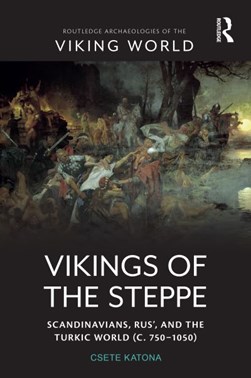-
BROWSE 1000s OF BOOKS IN STOCK
-
FREE DELIVERY ON ORDERS OVER €10
-
PRE-ORDER OBSESSED BY JOHNNY SEXTON
Vikings of the steppe
Hardback
Series: See all books in this series
The primary focus is the steppe influence on the development of Scandinavian-Rus' culture. It illustrates the effects of Turkic (nomadic) cultures on the evolving Scandinavian-Rus' communities in their military technology and tactics, as well as in everyday customs, ritual traditions and religious perceptions, whilst paying attention to the politico-commercial necessities and possible communication channels tying these two cultures, normally considered to be distinct, together. The arguments are supported by a multi-disciplinary analysis of diverse historical and archaeological materials occasionally supplemented with linguistic evidence. The result is a comprehensive evaluation of the relations of the Scandinavians active in the 'East' had with Turkic groups, and bring (the so far neglected) steppes into Viking studies in general. The book will fill a serious scholarly gap in the field of Viking Studies and will be read by both academics and students interested in the archaeological and historical sources concerned with the traditions of the 'Eastern Vikings'.
€188.50

565 Reward Points
In stock online
Extended Range: Delivery in 2-3 working days
Extended Range: Delivery in 2-3 working days
Free Delivery on this item
Any purchases for more than €10 are eligible for free delivery anywhere in the UK or Ireland!
The primary focus is the steppe influence on the development of Scandinavian-Rus' culture. It illustrates the effects of Turkic (nomadic) cultures on the evolving Scandinavian-Rus' communities in their military technology and tactics, as well as in everyday customs, ritual traditions and religious perceptions, whilst paying attention to the politico-commercial necessities and possible communication channels tying these two cultures, normally considered to be distinct, together. The arguments are supported by a multi-disciplinary analysis of diverse historical and archaeological materials occasionally supplemented with linguistic evidence. The result is a comprehensive evaluation of the relations of the Scandinavians active in the 'East' had with Turkic groups, and bring (the so far neglected) steppes into Viking studies in general. The book will fill a serious scholarly gap in the field of Viking Studies and will be read by both academics and students interested in the archaeological and historical sources concerned with the traditions of the 'Eastern Vikings'.

565 Reward Points
Any purchases for more than €10 are eligible for free delivery anywhere in the UK or Ireland!
€188.50

565 Reward Points
Any purchases for more than €10 are eligible for free delivery anywhere in the UK or Ireland!
Series: See all books in this series
Product Description
The primary focus is the steppe influence on the development of Scandinavian-Rus' culture. It illustrates the effects of Turkic (nomadic) cultures on the evolving Scandinavian-Rus' communities in their military technology and tactics, as well as in everyday customs, ritual traditions and religious perceptions, whilst paying attention to the politico-commercial necessities and possible communication channels tying these two cultures, normally considered to be distinct, together. The arguments are supported by a multi-disciplinary analysis of diverse historical and archaeological materials occasionally supplemented with linguistic evidence. The result is a comprehensive evaluation of the relations of the Scandinavians active in the 'East' had with Turkic groups, and bring (the so far neglected) steppes into Viking studies in general. The book will fill a serious scholarly gap in the field of Viking Studies and will be read by both academics and students interested in the archaeological and historical sources concerned with the traditions of the 'Eastern Vikings'.
Product Details
ISBN9780367480752
FormatHardback
PublisherROUTLEDGE (30 September. 2022)
No. of Pages184
Weight580
Language English
Dimensions 234 x 242 x 18

